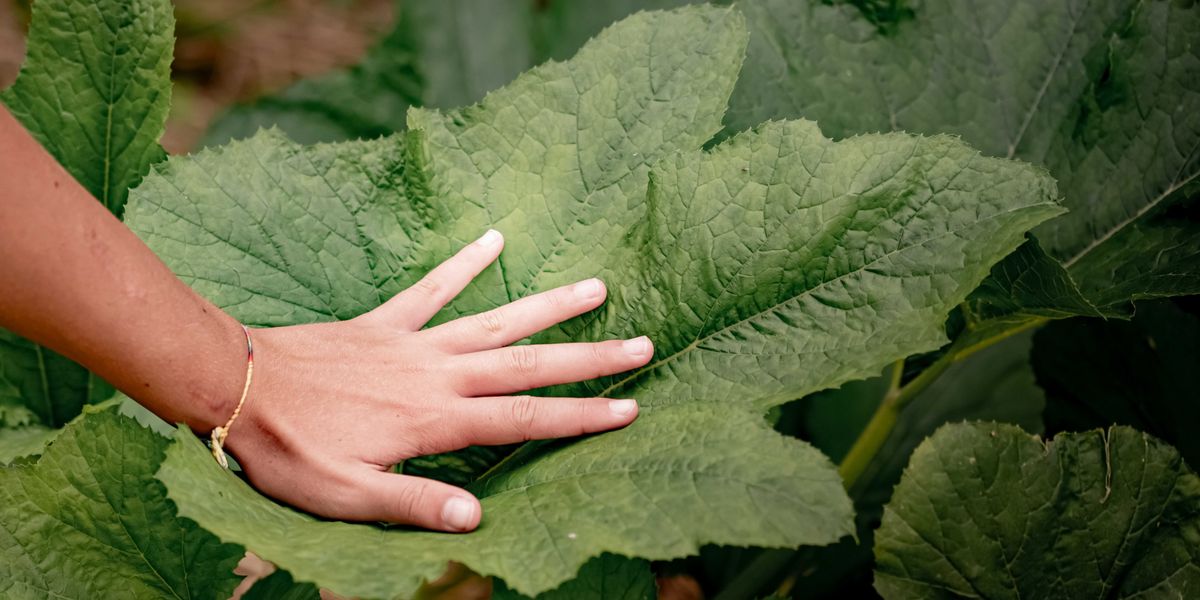aflatoxin
Study: Climate change will spread toxic mold to Midwest corn
Climate change is expanding the reach of aflatoxin, a chemical produced by a gray-green mold that infects corn crops and could threaten widespread damage to the country's lucrative Corn Belt.
Scientists develop 'Trojan horse' molecule to fight crop fungus linked to cancer.
Scientists said on Friday they had developed a new method to neutralize a dangerous fungal toxin affecting crops that can lead to cancer, childhood stunting and other health threats.
by Umberto Bacchi | @UmbertoBacchi | Thomson Reuters Foundation
Friday, 10 March 2017 19:00 GMT
ABOUT OUR FOOD COVERAGE
We explore the challenges of ending hunger and malnutrition as food production adjusts to a warming world
Share:
Newsletter sign up:
Most Popular
Syrian children turn to suicide, self-harm to escape horrors of war - report
From adventurers to inventors, Saudi women unite to inspire new generation
India's NGO crackdown forces U.S. Christian charity out after half a century
A #lifeinleggings: Caribbean women's movement fights sex assaults, harassment
Families of kidnapped Chibok girls welcome Nigerian president's return
"People are unfortunately consuming unknown and dangerous levels of these toxins pretty much on a daily basis"
By Umberto Bacchi
ROME, March 10 (Thomson Reuters Foundation) - Scientists said on Friday they had developed a new method to neutralise a dangerous fungal toxin affecting crops that can lead to cancer, childhood stunting and other health threats.
Researchers from the University of Arizona (UA) said they had created a genetically modified maize plant that is edible even when infected with a mould that produces aflatoxin, a carcinogenic substance.
About 16 million tons of maize, equivalent to almost the total output of South Africa, is thrown out each year worldwide due to contamination, as even small amounts can make an entire harvest unsafe for consumption.
In developed countries, commercial crops are screened for aflatoxin. But in many parts of the developing world contaminated food often ends up on the plate, as crops are not tested and small farmers depend on what they harvest to eat, the researchers said.
"People are unfortunately consuming unknown and dangerous levels of these toxins pretty much on a daily basis," said Monica Schmidt, assistant professor at UA's School of Plant Sciences.
The problem is heightened during droughts - whose frequency is expected to increase with climate change - as the fungus spreads more easily among stressed crops, she said.
In a study published in the journal Science Advances, Schmidt and her team said they had created a genetically engineered maize plant, which produces a "Trojan horse" molecule that jumps onto the fungus and shuts down its aflatoxin production.
Schmidt said the method should be transferable to other crops prone to aflatoxin contamination, like rice, soy and peanuts, as it exploits a naturally occurring biological mechanism known as RNA interference.
The method also has an advantage over other practices currently used to fight aflatoxin, like vacuum-sealed storage bags, as it tackles the fungus in the field rather than after harvest, Schmidt told the Thomson Reuters Foundation by phone.
She said initial analysis suggested the modified corn should not have any side-effect for consumers, but extensive field tests still needed to be conducted.
The toxin has been linked to stunted growth in children, increased risk of liver cancer, and higher susceptibility to HIV and malaria.
In 2004, Kenya suffered severe outbreaks of aflatoxin poisoning, which affected more than 300 people and killed more than 100 following a prolonged drought, according to the International Livestock Research Institute.
Why we need to transform our food systems urgently.
Transforming agri-food systems is critical and urgent - we have no choice but to turn the big ship before it is too late.
Globally, 25% of children under 5 are stunted. They are stunted because their diet lacks critical vitamins and minerals and because of early exposure to illnesses. As a result, they are too small for their age. They will never reach their full potential, because stunting affects their brain development as well as their height. In South Asia 38% of children under 5 are stunted. Globally, 2 billion people are malnourished while another 2 billion people are overweight and obese. They have an increased risk of chronic diseases such as diabetes and heart disease. In the United States 36% of adults are obese - although the majority of overweight and obese children in fact live in Asia and Africa. Type 2 diabetes is already exploding in India, as are coronary diseases in China.
Agriculture, on a global scale, is currently providing enough food to feed the seven billion people on the planet, but over half - four billion people - are eating in a way that is not healthy. Providing affordable access to healthy diets - solving malnutrition and obesity - has to join the imperative of providing enough food - solving hunger - as the number one priority for agriculture.
At the same time, agriculture is also the number one cause of planetary ill health. It causes some 30% of all greenhouse gas emissions, and is causing soil erosion on a scale that threatens future food security. Agriculture is the primary user of water in a water scarce world and the primary source of biodiversity loss. We cannot have a stable climate, food, health and water security, or safeguard biodiversity, if we do not transform our agri-food systems while we improve global diets.
So what is the future of agriculture? FAO tells us that the growing world population, with increasing income levels, will demand more food, in particular more meat, which will require a total growth in total food production of 60% by 2050. But while in the past increasing crop productivity was often the dominating concern for agriculture, in the future, far more focus needs to be placed on growing healthy food, on sustainable food systems that protect the environment, and on reducing the loss and waste of food post harvest. This requires major changes to our agri-food systems. And soon. Not impossible, but it's also not so simple to shift the course of the Titanic when the iceberg is already too close for comfort.
We know we can produce healthier foods to help solve malnutrition. CGIAR's program on biofortification, for example, has led to increases in vitamin and mineral contents of staple crops from beans, to sweet potatoes to rice. In rural Rwanda, where beans are often eaten twice a day, iron-rich varieties are helping combat deficiencies that lead to stunting and mental impairment. As more countries around the world adopt biofortification as part of a wider strategy to combat micronutrient deficiencies, CGIAR anticipates that more than 1 billion people will be benefitting from biofortified foods by 2030.
We can also help make food safer by reducing the toxic fungus that produces aflatoxin contamination in common foods such as maize or peanuts through a biocontrol product called Aflasafe, developed by CGIAR and USDA. A single application is effective for several years and in several crops. Aflasafe is now rapidly scaling up to reach millions of farmers and helping reduce the ill health caused by aflatoxin exposure that is widespread in poor African households.
We also know what to do to make agriculture more sustainable and to make it "climate smart". For example, in addition to farm practices, farmers in CGIAR's climate-smart villages project are also testing climate-smart services, such as tailored weather forecasts to plan planting, harvesting and other activities on the farm. Advisories and weather forecasts are being delivered by mobile phones, and phones are also being used to enable farmers to buy index-based insurance that gives them a measure of protection in the event of extreme weather.
Unfortunately, neither agriculture nor public health experts have yet found an effective solution to either prevent or reduce obesity. Obesity is a disease of poverty, inversely related to income levels, with many poor people living in food deserts. Providing healthy food that is affordable and accessible to all people, not only to those that can afford to shop for, cook and eat fruits and green vegetables, has to be an important contributing factor in the struggle against obesity, for which agriculture can take responsibility.
In the future, agricultural productivity can and must be increased in African farming systems, to provide food, income and employment for the next generation of Africans. This has now become one of the five top priorities of the African Development Bank, championed by its new President, Akin Adesina. At the same time, agriculture everywhere has to pay far more attention to providing climate-smart, healthier food that use natural resources more efficiently. We know how to do that but - critically - we need to develop the will to push far harder to ensure that it happens. This begins with greater increased awareness of the issues at all levels, from consumers to politicians. It will be a tough challenge to figure out how to prevent and reduce obesity, but agri-food systems can make a start with increased focus on making healthier food more affordable and accessible to poor consumers. If this all sounds like a tall order - it is, but we must stand up to the challenge.
Transforming agri-food systems is critical and urgent - we have no choice but to turn the big ship before it is too late. So many lives are at stake, and depend on our action. And, quite simply, we will not achieve sustainable development without it.
Follow Frank Rijsberman on Twitter: www.twitter.com/frankrijsberman
Extreme weather increasing level of toxins in food, scientists warn.
As they struggle to deal with more extreme weather, a range of food crops are generating more of chemical compounds that can cause health problems for people and livestock who eat them, scientists have warned.
NAIROBI, May 31 (Thomson Reuters Foundation) - As they struggle to deal with more extreme weather, a range of food crops are generating more of chemical compounds that can cause health problems for people and livestock who eat them, scientists have warned.
A new report by the United Nations Environment Programme (UNEP) says that crops such as wheat and maize are generating more potential toxins as a reaction to protect themselves from extreme weather.
But these chemical compounds are harmful to people and animals if consumed for a prolonged period of time, according to a report released during a United Nations Environment Assembly meeting in Nairobi.
"Crops are responding to drought conditions and increases in temperature just like humans do when faced with a stressful situation," explained Jacqueline McGlade, chief scientist and director of the Division of Early Warning and Assessment at UNEP.
Under normal conditions, for instance, plants convert nitrates they absorb into nutritious amino acids and proteins. But prolonged drought slows or prevents this conversion, leading to more potentially problematic nitrate accumulating in the plant, the report said.
If people eat too much nitrate in their diets, it can interfere with the ability of red blood cells to transport oxygen in the body, the report said.
Crops susceptible to accumulating too much nitrate in times of stress include maize, wheat, barley, soybeans, millet and sorghum, it said.
DROUGHT, THEN RAIN
Some drought-stressed crops, when then exposed to sudden large amounts of rain that lead to rapid growth, in turn accumulate hydrogen cyanide, more commonly known as prussic acid, the report said.
Prussic acid - one of the ingredients used in some types of chemical warfare - interferes with oxygen flow in humans. Even short-term exposure can be debilitating for people, McGlade said.
Plants such as cassava, flax, maize and sorghum are most vulnerable to dangerous prussic acid accumulation, the report said.
Cases of nitrate or hydrogen cyanide poisoning in humans were reported in Kenya in 2013 and in the Philippines in 2005, McGlade said. In Kenya, two children died in coastal Kilifi after eating cassava that had raised levels of prussic acid in it following extreme rainfall, according to local media reports.
Aflatoxins, molds that can affect plant crops and raise the risk of liver damage, cancer and blindness, as well as stunting foetuses and infants, also are spreading to more areas as a result of shifting weather patterns as a result of climate change, scientists said.
McGlade said about 4.5 billion people in developing countries are exposed to aflatoxins each year, though the amounts are largely unmonitored, and the numbers are rising.
"We are just beginning to recognise the magnitude of toxin- related issues confronting farmers in developing countries of the tropics and sub-tropics," the report noted.
"As warmer climate zones expand towards the poles, countries in more temperate regions are facing new threats," it added.
In 2004, Kenya suffered severe outbreaks of aflatoxin poisoning, which affected more than 300 people and killed more than 100 following a prolonged drought, according to the International Livestock Research Institute.
EUROPE AT RISK
The UNEP report said Europe will be at growing risk from aflatoxins in locally grown crops if global temperatures rise by at least 2 degrees Celsius. The world is currently on a path to a more than 3 degree Celsius temperature rise, scientists believe.
An increase in toxic compounds in crops is likely to impact heavily on the world's health system, which are already struggling with the effects of food insecurity, Dorota Jarosinska of the World Health Organization's European Center for Environment and Health said in an interview with the Thomson Reuters Foundation.
Alex Ezeh, executive director of the African Population Health and Research Center, said the increase in toxins in crops was a big concern.
"Toxic crops can lead to neurological diseases among humans but the greatest challenge is the incidence of cancer," he said in an interview.
The report proposes a list of eight ideas farmers and agricultural experts can adopt to try to limit damage from more crop toxins, such as mapping contamination hotspots and building better evidence about what is happening now with the toxins in their area.
Scientists also suggest that developing crop varieties designed to cope with extreme weather could help reduce the levels of toxic chemicals in food.
"Research centers with the Consultative Group on International Agricultural Research are developing seeds that are suitable in various regions that have been hit by climate change," McGlade said.
(Reporting by Kagondu Njagi; editing by Laurie Goering :; Please credit the Thomson Reuters Foundation, the charitable arm of Thomson Reuters, that covers humanitarian news, climate change, women's rights, trafficking and property rights. Visit news.trust.org/climate)
Crops are becoming toxic to withstand extreme weather conditions.
When plants adapt to the harsh environment, they accumulate toxins to dangerous levels that can kill livestock and can cause cancer and other serious illnesses in humans according to a report by the United Nations Environment Programme (UNEP).
What kind of crops are we importing if they are coming in from places that are prone to drought and intense rainfall?
May 27, 2016- It is not the drought as you know it. Scientists are saying so because they have found that it is not just about scarce water. They say that when the life sustaining liquid becomes quite scarce, plants find a way of surviving the extreme condition. And that is where the good news ends. The bad news is that when plants adapt to the harsh environment, they accumulate toxins to dangerous levels that can kill livestock and can cause cancer and other serious illnesses in humans.
How about heavy rainfall after a prolonged drought? If you thought it could be a respite for us all, you are in for a surprise. A new report has shown even drought-breaking intense rains can lead to accumulation of dangerous toxins in plants. Welcome to the world of extreme weathers and toxic crops.
70 percent toxic
That is the dire message the United Nations Environment Programme (UNEP) has delivered through a report released during its second general assembly this week. Scientists who wrote the report say extreme weather conditions and rising temperatures will make 70 percent of the world’s agricultural production toxic to animals and humans across the globe.
Such toxins include nitrate and prussic acid. The first one gets accumulated in crops like wheat, barley maize, millet, soybean, among others, because of acute droughts, the UNEP report says. The second one gets deposited in crops such as flax, maize, coffee, cherries, apples, among others, as a result of heavy rainfall after prolonged dryness.
In normal conditions, plants can turn nitrates into protein. But during extreme weather conditions, they cannot complete that process and the chemicals accumulate.
Several research before the UNEP report had found that nitrate and prussic acid poisoning occurs when cattle eat forage stressed by severe environmental conditions. The toxin converts the oxygen-carrying haemoglobin in the blood to methemoglobin which cannot carry the life supporting gas.
Worse news for us
While that is already bad news for small scale farmers and herders, mainly in poor countries like Nepal, there is even worse news. The UNEP report has warned that over 4.5 billion people from the developing world are at risk of exposure to a particular highly harmful toxin in crops.
It is known as aflatoxin, one of the mycotoxins that are chemical by-products of fungal growth causing severe damage to the health of animals and humans even at small concentrations. Mycotoxins fungi infect many crops such as coffee, groundnut, maize, oilseeds, peanut, sorghum, tree nuts, and wheat.
“In many African and Central American countries, a subsistence farmer may eat 500 grams of maize per day,” Professor John Leslie of Kansas State University told me in an interview I did for the BBC. “They can easily be exposed to threatening levels of aflatoxin, even if the grain meets the safety standards set by the EU.” In Kenya, for instance, hundreds of human death cases were attributed to the consumption of aflatoxin contaminated maize products some years ago.
“That prompted the Kenyan government to condemn 2.3 million bags of maize,” agriculture scientist Jagger Harvey, one of the authors of the UNEP report, told the BBC. Scientists say mycotoxins including aflatoxins get accumulated in crops because of increasing temperatures. And now the toxin is expected to contaminate crops in higher latitude.
A study published in 2013 showed aflatoxins were found in maize grown in different regions of Serbia because of hot and dry weather with prolonged drought during the spring and summer of 2012. Another study said the contamination in maize could become a food security issue in Europe. But, as you can imagine, European agro scientists might find one or the other way to deal with the issue.
Even in Africa, research is gaining ground. “Initiatives like the Partnership for Aflatoxin Control in Africa have been established to work with policymakers and other key stakeholders on the African continent, to help them address this particular challenge in concert,” said Professor Harvey. “We are at a critical point where the risk for contamination is significant, and potentially expanding; and interventions are being developed, adapted and deployed to address this issue globally.”
Our food security
The question now is: Will Nepal be able to take advantage of such solutions? Before seeking an answer to that, you need to ask a more fundamental question: Does Nepal even know what is happening to its crops in the wake of extreme weather events?
Or, do we know what kind of crops we are importing if they are coming in from places that are prone to drought and intense rainfall? The UNEP report has pointed out there is no dearth of such places now. And as Professor Leslie said: Food security has both quantity and quality aspects to it. “People need enough calories, but they also need to include essential nutrients and to exclude noxious contaminants such as disease-causing organisms and toxic chemicals.”
Khadka is a BBC journalist based in London
Published: 27-05-2016 08:41









